Citroen C4 CACTUS 2014 1.G Owner's Manual
Manufacturer: CITROEN, Model Year: 2014, Model line: C4 CACTUS, Model: Citroen C4 CACTUS 2014 1.GPages: 331, PDF Size: 9 MB
Page 131 of 331
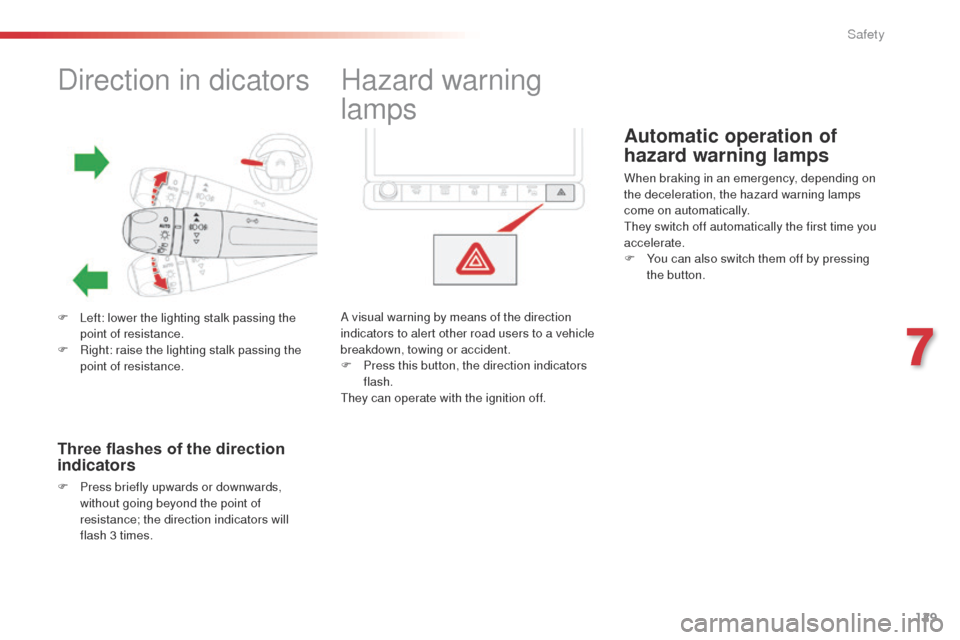
129
E3_en_Chap07_securite_ed01-2014
Direction in dicators
F Left: lower the lighting stalk passing the point of resistance.
F
R
ight: raise the lighting stalk passing the
point of resistance.
Three flashes of the direction
indicators
F Press briefly upwards or downwards, without going beyond the point of
resistance; the direction indicators will
flash 3 times.
Hazard warning
lamps
A visual warning by means of the direction
indicators to alert other road users to a vehicle
breakdown, towing or accident.
F
P
ress this button, the direction indicators
flash.
They can operate with the ignition off.
Automatic operation of
hazard warning lamps
When braking in an emergency, depending on
the deceleration, the hazard warning lamps
come on automatically.
They switch off automatically the first time you
accelerate.
F
Y
ou can also switch them off by pressing
the button.
7
Safety
Page 132 of 331
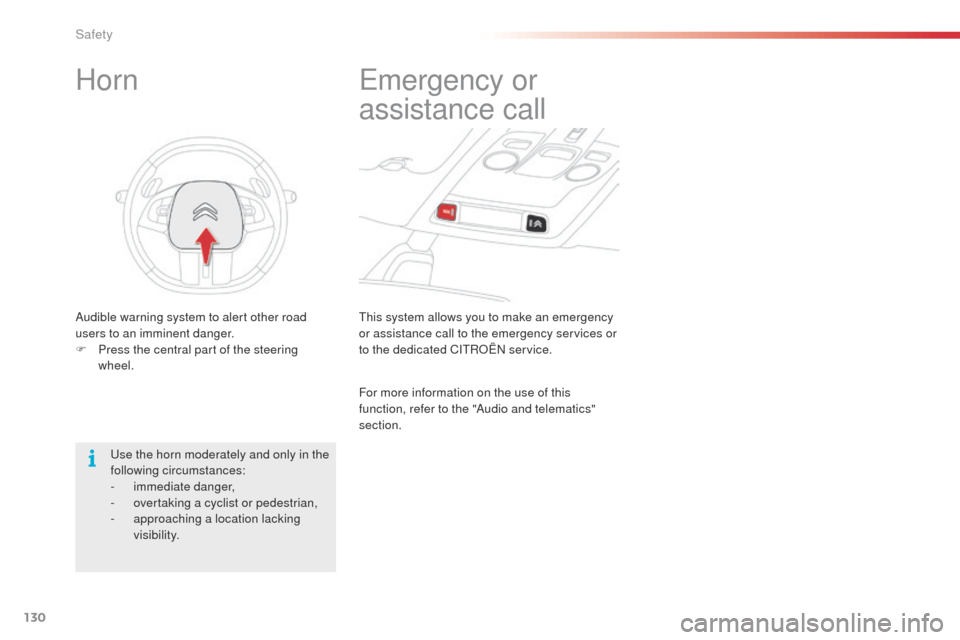
130
E3_en_Chap07_securite_ed01-2014
This system allows you to make an emergency
or assistance call to the emergency services or
to the dedicated CITROËN service.
Emergency or
assistance call
For more information on the use of this
function, refer to the "Audio and telematics"
section.
Horn
Audible warning system to alert other road
users to an imminent danger.
F
P
ress the central part of the steering
wheel.
Use the horn moderately and only in the
following circumstances:
-
i
mmediate danger,
-
ov
ertaking a cyclist or pedestrian,
-
a
pproaching a location lacking
visibility.
Safety
Page 133 of 331
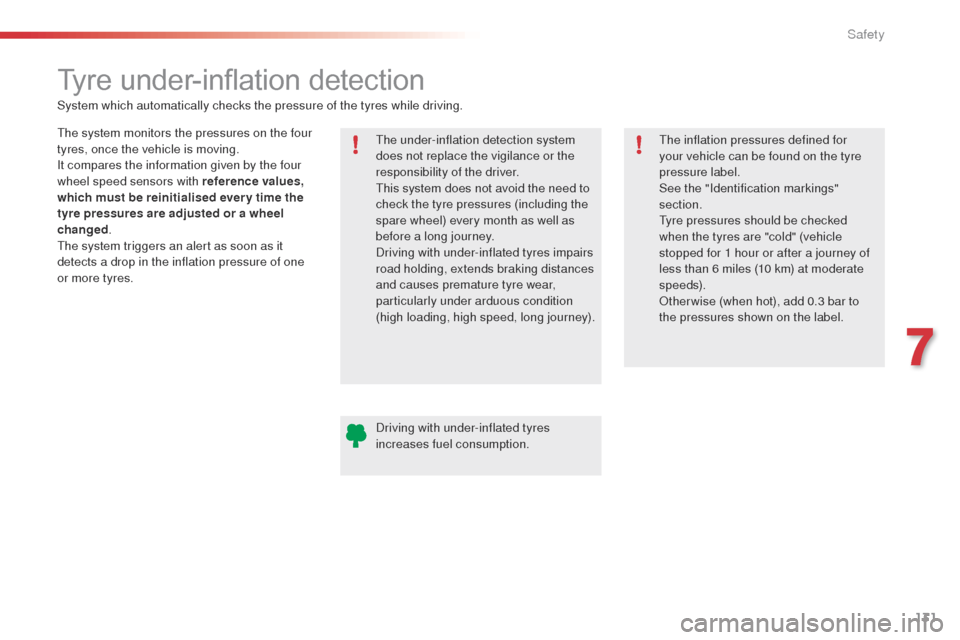
131
E3_en_Chap07_securite_ed01-2014
Tyre under-inflation detection
The system monitors the pressures on the four
tyres, once the vehicle is moving.
It compares the information given by the four
wheel speed sensors with reference values,
which must be reinitialised ever y time the
tyre pressures are adjusted or a wheel
changed.
The system triggers an alert as soon as it
detects a drop in the inflation pressure of one
or more tyres. The under-inflation detection system
does not replace the vigilance or the
responsibility of the driver.
This system does not avoid the need to
check the tyre pressures (including the
spare wheel) every month as well as
before a long journey.
Driving with under-inflated tyres impairs
road holding, extends braking distances
and causes premature tyre wear,
particularly under arduous condition
(high loading, high speed, long journey).
System which automatically checks the pressure of the tyres while driving.
The inflation pressures defined for
your vehicle can be found on the tyre
pressure label.
See the "Identification markings"
section.
Tyre pressures should be checked
when the tyres are "cold" (vehicle
stopped for 1 hour or after a journey of
less than 6 miles (10 km) at moderate
speeds).
Other wise (when hot), add 0.3 bar to
the pressures shown on the label.
Driving with under-inflated tyres
increases fuel consumption.
7
Safety
Page 134 of 331
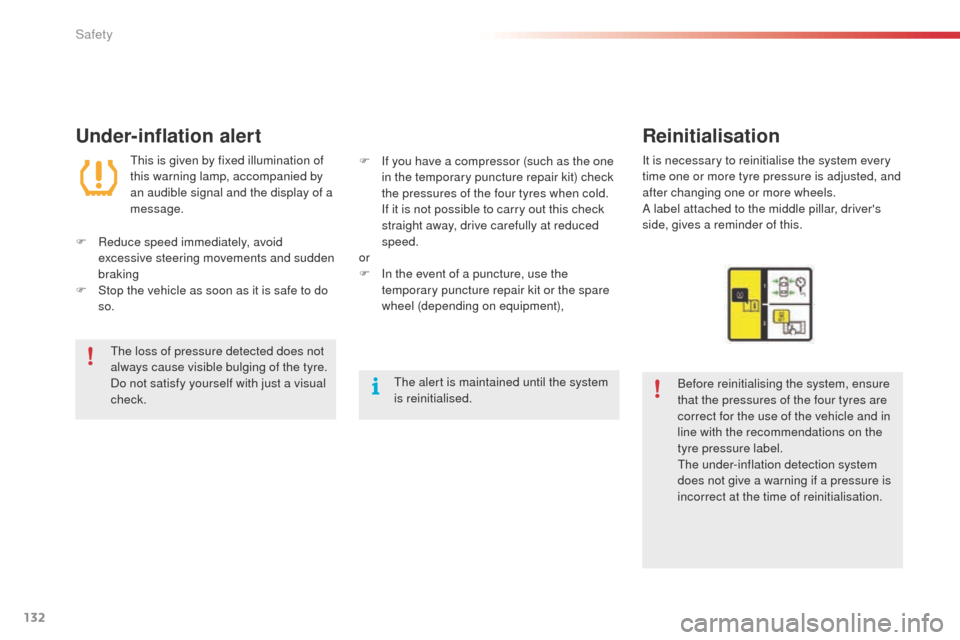
132
E3_en_Chap07_securite_ed01-2014
Under-inflation alertReinitialisation
Before reinitialising the system, ensure
that the pressures of the four tyres are
correct for the use of the vehicle and in
line with the recommendations on the
tyre pressure label.
The under-inflation detection system
does not give a warning if a pressure is
incorrect at the time of reinitialisation.
This is given by fixed illumination of
this warning lamp, accompanied by
an audible signal and the display of a
message.
It is necessary to reinitialise the system every
time one or more tyre pressure is adjusted, and
after changing one or more wheels.
A label attached to the middle pillar, driver's
side, gives a reminder of this.
F
R
educe speed immediately, avoid
excessive steering movements and sudden
braking
F
S
top the vehicle as soon as it is safe to do
so. F
I
f you have a compressor (such as the one
in the temporary puncture repair kit) check
the pressures of the four tyres when cold.
If it is not possible to carry out this check
straight away, drive carefully at reduced
speed.
or
F
I
n the event of a puncture, use the
temporary puncture repair kit or the spare
wheel (depending on equipment),
The loss of pressure detected does not
always cause visible bulging of the tyre.
Do not satisfy yourself with just a visual
check. The alert is maintained until the system
is reinitialised.
Safety
Page 135 of 331
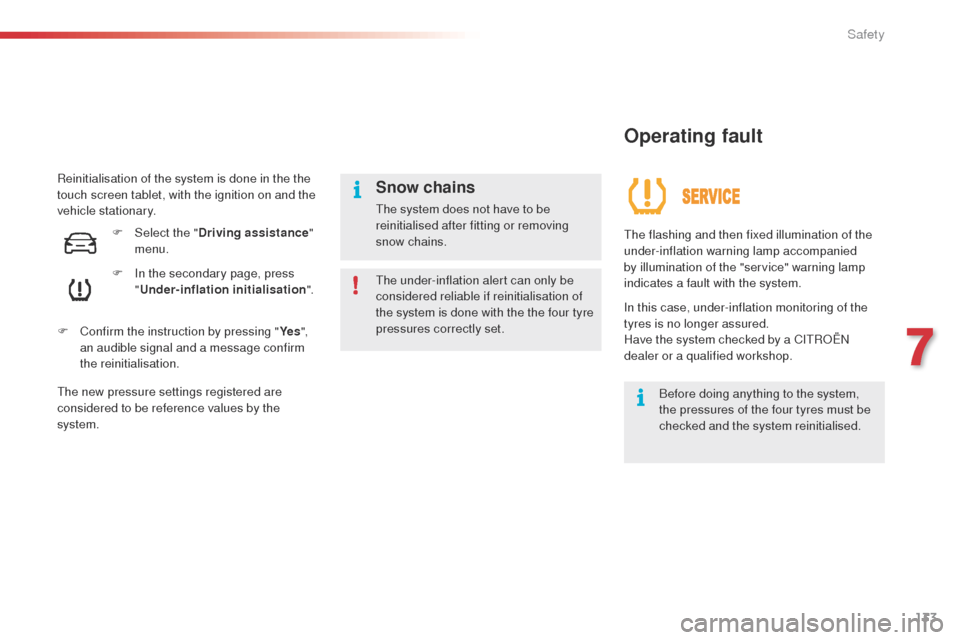
133
E3_en_Chap07_securite_ed01-2014
Reinitialisation of the system is done in the the
touch screen tablet, with the ignition on and the
vehicle stationary.F
I
n the secondary page, press
" Under-inflation initialisation ".
F
C
onfirm the instruction by pressing " Ye s",
an audible signal and a message confirm
the reinitialisation.
The new pressure settings registered are
considered to be reference values by the
system.
Operating fault
The flashing and then fixed illumination of the
under-inflation warning lamp accompanied
by illumination of the "service" warning lamp
indicates a fault with the system.
In this case, under-inflation monitoring of the
tyres is no longer assured.
Have the system checked by a CITROËN
dealer or a qualified workshop.
Before doing anything to the system,
the pressures of the four tyres must be
checked and the system reinitialised.
The under-inflation alert can only be
considered reliable if reinitialisation of
the system is done with the the four tyre
pressures correctly set.
Snow chains
The system does not have to be
reinitialised after fitting or removing
snow chains.
F
Sel
ect the " Driving assistance "
menu.
7
Safety
Page 136 of 331
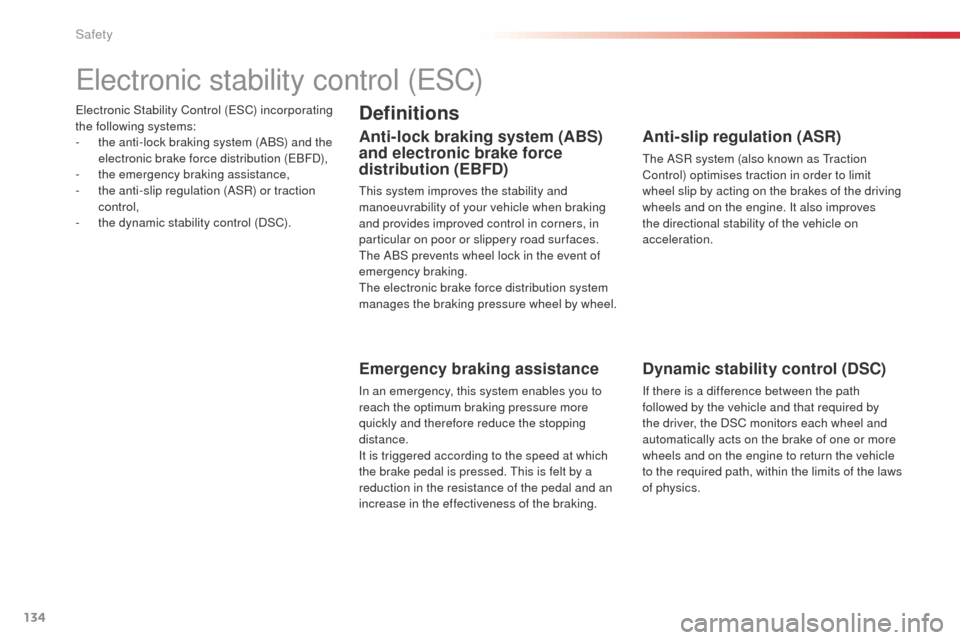
134
E3_en_Chap07_securite_ed01-2014
Electronic Stability Control (ESC) incorporating
the following systems:
-
t
he anti-lock braking system (ABS) and the
electronic brake force distribution (EBFD),
-
t
he emergency braking assistance,
-
t
he anti-slip regulation (ASR) or traction
control,
-
t
he dynamic stability control (DSC).
Electronic stability control (ESC)
Definitions
Anti-lock braking system (ABS)
and electronic brake force
distribution (EBFD)
This system improves the stability and
manoeuvrability of your vehicle when braking
and provides improved control in corners, in
particular on poor or slippery road sur faces.
The ABS prevents wheel lock in the event of
emergency braking.
The electronic brake force distribution system
manages the braking pressure wheel by wheel.
Emergency braking assistance
In an emergency, this system enables you to
reach the optimum braking pressure more
quickly and therefore reduce the stopping
distance.
It is triggered according to the speed at which
the brake pedal is pressed. This is felt by a
reduction in the resistance of the pedal and an
increase in the effectiveness of the braking.
Anti-slip regulation (ASR)
The ASR system (also known as Traction
Control) optimises traction in order to limit
wheel slip by acting on the brakes of the driving
wheels and on the engine. It also improves
the directional stability of the vehicle on
acceleration.
Dynamic stability control (DSC)
If there is a difference between the path
followed by the vehicle and that required by
the driver, the DSC monitors each wheel and
automatically acts on the brake of one or more
wheels and on the engine to return the vehicle
to the required path, within the limits of the laws
of physics.
Safety
Page 137 of 331
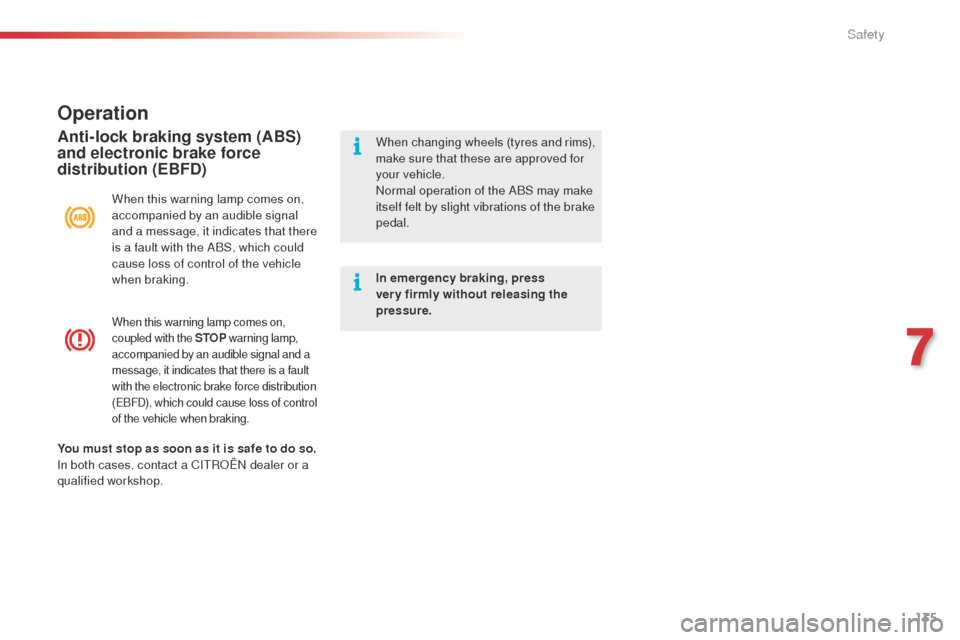
135
E3_en_Chap07_securite_ed01-2014
When this warning lamp comes on,
coupled with the STOP warning lamp,
accompanied by an audible signal and a
message, it indicates that there is a fault
with the electronic brake force distribution
(EBFD), which could cause loss of control
of the vehicle when braking.
Operation
When this warning lamp comes on,
accompanied by an audible signal
and a message, it indicates that there
is a fault with the ABS, which could
cause loss of control of the vehicle
when braking.
Anti-lock braking system (ABS)
and electronic brake force
distribution (EBFD)When changing wheels (tyres and rims),
make sure that these are approved for
your vehicle.
Normal operation of the ABS may make
itself felt by slight vibrations of the brake
pedal.
In emergency braking, press
very firmly without releasing the
pressure.
You must stop as soon as it is safe to do so.
In both cases, contact a CITROËN dealer or a
qualified workshop.
7
Safety
Page 138 of 331
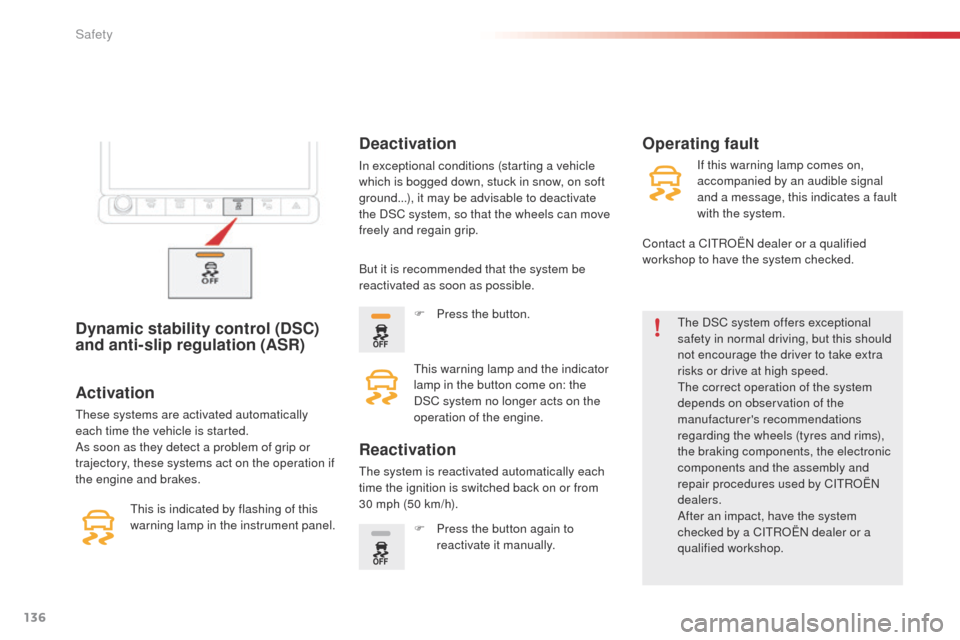
136
E3_en_Chap07_securite_ed01-2014
Dynamic stability control (DSC)
and anti-slip regulation (ASR)The DSC system offers exceptional
safety in normal driving, but this should
not encourage the driver to take extra
risks or drive at high speed.
The correct operation of the system
depends on observation of the
manufacturer's recommendations
regarding the wheels (tyres and rims),
the braking components, the electronic
components and the assembly and
repair procedures used by CITROËN
dealers.
After an impact, have the system
checked by a CITROËN dealer or a
qualified workshop.
Activation
These systems are activated automatically
each time the vehicle is started.
As soon as they detect a problem of grip or
trajectory, these systems act on the operation if
the engine and brakes.
Deactivation
In exceptional conditions (starting a vehicle
which is bogged down, stuck in snow, on soft
ground...), it may be advisable to deactivate
the DSC system, so that the wheels can move
freely and regain grip.
This is indicated by flashing of this
warning lamp in the instrument panel.
Operating fault
But it is recommended that the system be
reactivated as soon as possible. F
P
ress the button.
This warning lamp and the indicator
lamp in the button come on: the
DSC system no longer acts on the
operation of the engine.
Reactivation
The system is reactivated automatically each
time the ignition is switched back on or from
30 mph (50 km/h). F
P
ress the button again to
reactivate it manually. If this warning lamp comes on,
accompanied by an audible signal
and a message, this indicates a fault
with the system.
Contact a CITROËN dealer or a qualified
workshop to have the system checked.
Safety
Page 139 of 331
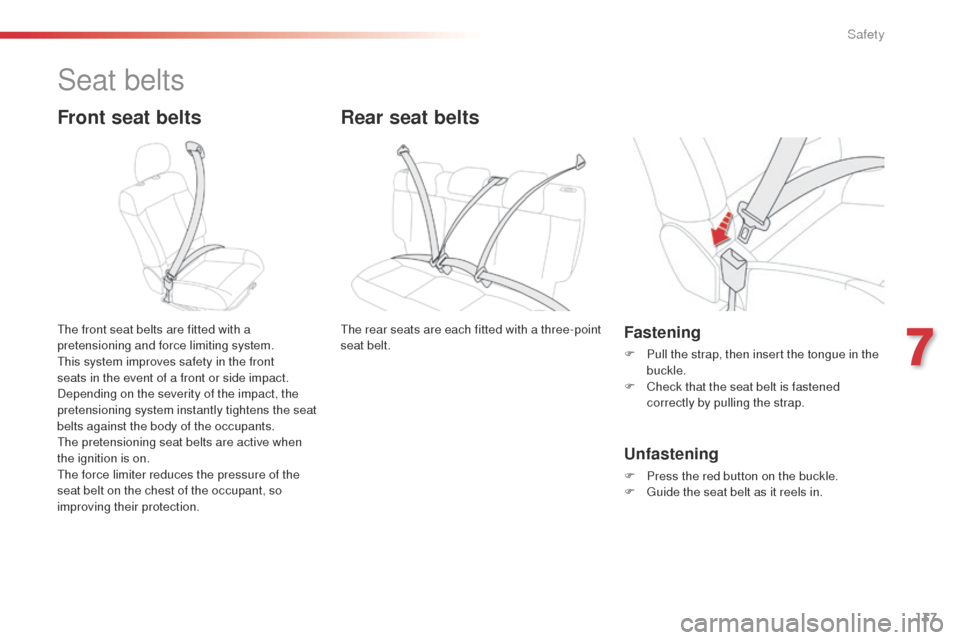
137
E3_en_Chap07_securite_ed01-2014
Seat belts
Front seat belts
The front seat belts are fitted with a
pretensioning and force limiting system.
This system improves safety in the front
seats in the event of a front or side impact.
Depending on the severity of the impact, the
pretensioning system instantly tightens the seat
belts against the body of the occupants.
The pretensioning seat belts are active when
the ignition is on.
The force limiter reduces the pressure of the
seat belt on the chest of the occupant, so
improving their protection.Fastening
F Pull the strap, then insert the tongue in the buckle.
F
C
heck that the seat belt is fastened
correctly by pulling the strap.
Unfastening
F Press the red button on the buckle.
F G uide the seat belt as it reels in.
Rear seat belts
The rear seats are each fitted with a three-point
seat belt.
7
Safety
Page 140 of 331
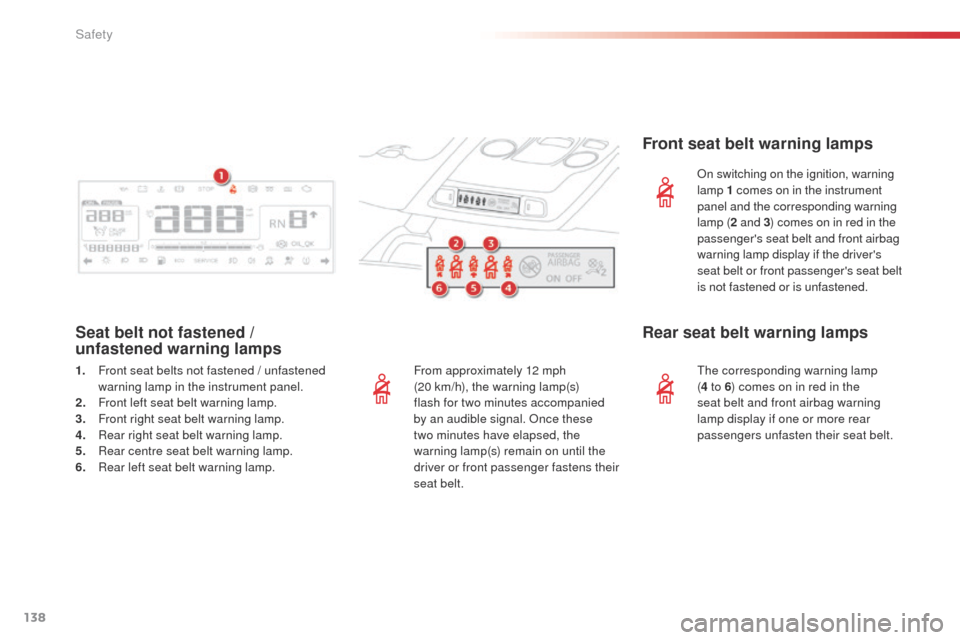
138
E3_en_Chap07_securite_ed01-2014
From approximately 12 mph
(20 km/h), the warning lamp(s)
flash for two minutes accompanied
by an audible signal. Once these
two
minutes have elapsed, the
warning lamp(s) remain on until the
driver or front passenger fastens their
seat belt.
Seat belt not fastened /
unfastened warning lamps Front seat belt warning lamps
On switching on the ignition, warning
lamp
1 comes on in the instrument
panel and the corresponding warning
lamp ( 2 and 3 ) comes on in red in the
passenger's seat belt and front airbag
warning lamp display if the driver's
seat belt or front passenger's seat belt
is not fastened or is unfastened.
1.
F
ront seat belts not fastened / unfastened
warning lamp in the instrument panel.
2.
F
ront left seat belt warning lamp.
3.
F
ront right seat belt warning lamp.
4.
R
ear right seat belt warning lamp.
5.
R
ear centre seat belt warning lamp.
6.
R
ear left seat belt warning lamp.
Rear seat belt warning lamps
The corresponding warning lamp
( 4
to 6 ) comes on in red in the
seat belt and front airbag warning
lamp display if one or more rear
passengers unfasten their seat belt.
Safety